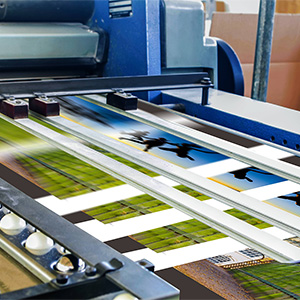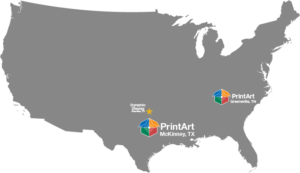It’s all about the screens. Well, who cares about screens? If you buy offset color printing services you should know the differences between the 2 different screen technologies used in commercial printing. It affects the quality of all your color printing. You may know some of this stuff, but most people who buy printing don’t know what you will learn in this article. This is a little technical but stick with it because you may want to make some changes in the way your printing is printed. So let’s get started.
Here is how it works. Your files go to pre-press where they are reviewed for technical errors before being made into screens for printing; it is the first step in the process. Customer files then go to a plate maker to be processed and then transferred (offset) to 4 different metal plates, one each of cyan, magenta, yellow and black. Each plate transfers the ink to a rubber blanket and the blanket offsets the ink onto the paper.
Most commercial printers use conventional AM (amplitude modulated) line screens, that are dots arranged in a rosette pattern to makes images. That means each screen plate has to align perfectly at very high-speeds of rotations of the press cylinder to keep registration sharp. A typical press run speed alignment of the plates can be unstable. The way it works is some dots are large and some dots are small depending on their tonal value. The bigger the dots the more ink they pick-up.
The most commonly used line screen dots are from 150 to 300 dots per inch depending on the screens used by the printing firm. Printing companies choose a type of screen and use it for all their printing, so you can’t ask your printer to use high dot line screens. A problem is conventional screens use a lot of ink that pools together. The detail is reduced caused by flooding the paper with too much ink. The color gamut is the range of colors that can be printed. Too much ink inhibits subtle colors and tones are lost because the color gamut is reduced. Subtle colors cannot be printed and moiré patterns can occur in textures and patterns. Another issue is banding in color gradations because it is difficult to print smooth transitions of color tones with AM screens.
The other screening method is known as FM (frequency modulated) stochastic (stuh-kas-tic) screens. There are different brands and they all have their own unique proprietary variations. These types of screens are different because FM screens are made with tiny specks similar to grain in photographs. As an example, I will discuss Kodak Staccato brand screens, which I am most familiar with.
FM screens use 20-micron irregular specs to print color. 1 micron equals 0.000093701 of an inch or 1,000,000 to one yard. A 20-micron screen prints 1,270 specs per inch. These tiny microscopic specks are ideal for printing high-definition details in photography, artwork, type, and smooth color gradations.
Stochastic screens offer many advantages over conventional screens. They improve detail and definition, reversed text prints cleaner. They improve shadow and highlight detail, also a larger color gamut so more colors can be printed using conventional line screens. FM screens eliminate unwanted screen angle moiré, subject moiré, and rosettes. The result is photographic like continuous tone appearance with more color stability during the press run. When tonal and color instability occurs using stochastic screens and off-register occurs sharpness and quality are not affected. These are just some of the benefits FM screens.
Hopefully, this has shed a little light on High Definition printing. It can be a fairly complex process but don’t feel overwhelmed, reach out to PrintArt today and explain what you need. Their customer service department will put together a cost-effective quote and help your vision come to reality!.
PrintArt – Accurate Die Cutting
413 Interchange St.
McKinney, TX 75071
972.562.7921
https://www.printart-adc.com


